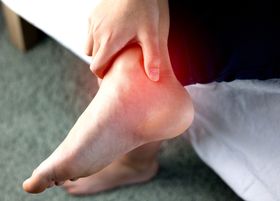Grierson-Gopalan Syndrome (Burning Feet)—Symptoms, Causes & Treatments
Updated August 29, 2025

Burning feet syndrome can be quite painful and agitating, which is why we’ve decided to provide information on possible causes, symptoms, how the condition is diagnosed, and different treatment options to help you quickly get back on your feet.
What Is Grierson-Gopalan Syndrome (Burning Feet Syndrome)?
Grierson-Gopalan syndrome, more commonly known as burning feet syndrome, is a medical condition that causes severe aching and burning sensations in the feet. This sensation is often worse at night and restricted to the soles of the feet. Sometimes, however, it can spread to the top of the feet, ankles, and lower leg. It can also affect the eyes and cause scotoma and amblyopia
» Need insoles for Grierson-Gopalan syndrome? Check out our picks of the best insoles for burning feet syndrome
Symptoms of Burning Feet Syndrome
The most common symptoms of Grierson-Gopalan syndrome include:
- Severe aching and burning sensation in the feet, often worsening at night
- Feet numbness and heaviness
- Redness of the skin
- Sharp or stabbing pain
- Prickling or tingling sensation
- Hypersensitivity
- Vasomotor changes that can lead to excessive sweating
Grierson-Gopalan Syndrome Diagnosis
Before making a diagnosis of burning feet syndrome, the doctor will ask about the history of your symptoms. This will help determine the course of the symptoms' progressions and their severity.
A physical examination will also be conducted on the feet to identify any observable changes, after which a blood test will be ordered to screen for nutritional deficiencies and endocrinal disorders. You might also be asked to take a nerve function test if nerve damage is suspected.
Causes of Burning Feet Syndrome
There are many different conditions that can cause burning feet syndrome. For the sake of convenience, we have grouped the causes into the following categories:
- Metabolic disorders An underactive thyroid (hypothyroidism) or a case of type 1 and 2 diabetes can cause a burning sensation in the feet.
- Infections With a fungal infection like athlete's foot, the person may develop several symptoms including itching, stinging, and burning of feet.
- Nutritional deficiency A deficiency of vitamins B5, B-12, and E can cause a sensation of burning feet.
- Nerve damage When nerve damage occurs either due to illness, trauma, surgery, toxins, or chemotherapy drugs, it can result in conditions like Charcot-Marie-Tooth, complex pain regional syndrome (CRPS), Morton’s neuroma, peripheral neuropathy, and tarsal tunnel syndrome to name a few. All of these named conditions are associated with burning feet syndrome.
- Stress Any physical activity exercise that requires prolonged standing on the feet can cause stress and associated burning and numbness.
- Improper footwear Ill-fitting or tight-fitting shoes when worn against sensitive feet will cause more pressure to be exerted on some areas of the foot and can cause a burning sensation.
- Other conditions Several other conditions like allergies, contact dermatitis, erythromelalgia, and multiple sclerosis, can also present with burning feet syndrome.
» Learn more about the causes of burning feet
Treatment for Grierson-Gopalan Syndrome
When it comes to the treatment for burning feet syndrome, there are some alternatives along with the prescribed medication that can help alleviate the symptoms.
Using custom orthotics has proven to be effective in the management of burning feet syndrome, as these will cushion the feet, relieving pressure and any pain that the syndrome may be causing.
Once you have your foot impression from your podiatrist, you can register on Upstep to have a custom orthotic made for a fee and then shipped to your location without any compromise of quality.
We recommend Burning Feet Syndrome Custom Orthotics, designed to cushion the painful areas while reducing the underlying causes at the same time.
Pros
- Custom made
- Addresses your foot needs directly
- 180-day money-back guarantee
- FSA and HSA eligible
- Free shipping and returns
Cons
- Short waiting period before receiving orthotics
Upstep custom-made orthotics are made from durable materials and are specifically designed to fit your lifestyle while reducing the pain caused by burning feet syndrome.
What Medications Are Prescribed for the Treatment of Burning Feet?
Should the condition worsen, or fail to improve even with conservative treatment, you may need to visit a doctor or a podiatrist, who will have you examined carefully to determine the cause and more appropriate method of treatment.
Commonly prescribed medications for burning feet are:
- Amitriptyline
- Carbamazepine (Tegretol)
- Desipramine (Norpramin)
- Duloxetine (Cymbalta)
- Gabapentin (Neurontin)
Home Remedies for Burning Feet Syndrome
Burning feet syndrome treatment can also be carried out at home with some alternative remedies that may help relieve the symptoms, however, this is dependent on the exact cause.
The best is to avoid exposing your feet to extreme temperatures (cold or heat). Instead, you can consider soaking your feet in warm water periodically for up to 15 minutes at a time.
» Check out these effective home remedies for burning feet syndrome
Can Burning Feet Syndrome Be Prevented?
While it may be impossible to prevent burning feet syndrome as the potential causes are many, you can prevent it from getting worse. Taking good care of your feet and wearing properly fitted shoes is a good place to start, as well as ensuring that you always wear clean and dry socks to minimize the chance of infections.








